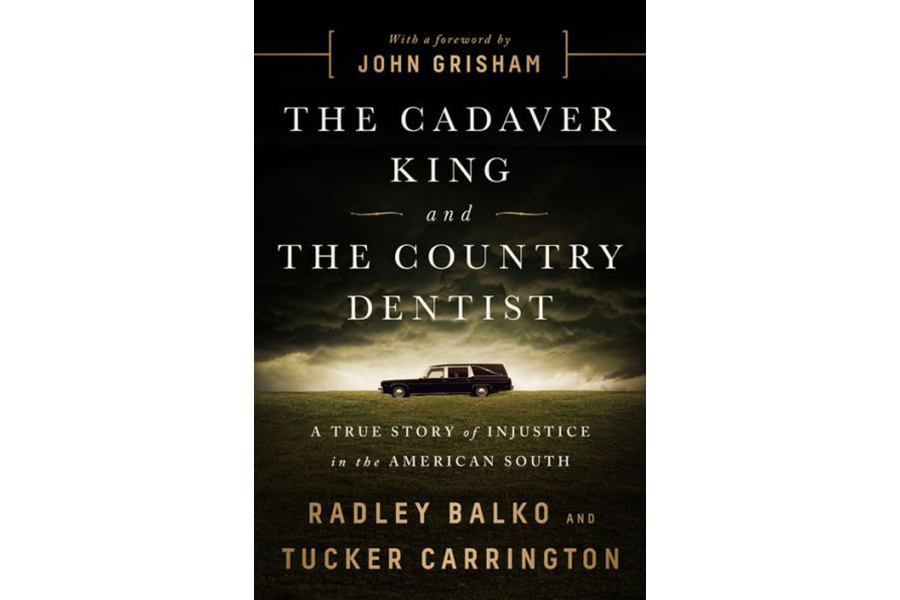'The Cadaver King and The Country Dentist' will shake your faith in the US justice system
Loading...
For those who believe in the sanctity of the rule of law, that justice – the foundation of civilization – is blind, this book will be most unsettling. The two authors, Radley Balko and Tucker Carrington, make the case beyond a reasonable doubt that the justice system in places like Mississippi has been rigged for decades.
By the book’s conclusion, it is difficult to disagree with John Grisham’s opening statement in his foreword: “It is relatively easy to convict an innocent person.”
In The Cadaver King and The Country Dentist: A True Story of Injustice in the American South, the authors focus on the wrongful convictions of two black men, Levon Brooks and Kennedy Brewer, each charged in separate murders during the early 1990s in Mississippi – of Courtney Smith and Christine Jackson respectively. Both victims were three-year-old black girls.
Balko is a journalist with The Washington Post and Carrington is a criminal defense lawyer and the director of the George C. Cochran Innocence Project at the University of Mississippi School of Law.
These two cases seem almost medieval in their particulars. The men are railroaded largely by the courtroom wizardry of two practitioners of forensic science, Dr. Steven Hayne and Dr. Michael West. The former performed autopsies for two decades in Mississippi criminal cases – averaging an astonishing five “McAutopsies” a day in some years – and the latter is a dentist who peddled his purported expertise in matching bite marks on victims with the teeth of alleged perpetrators.
The use of bite marks as damning evidence first emerged in 1974 and had a good run until 2009, when the National Academy of Sciences damned the practice in a report on the state of forensics in American courtrooms. Spoiler alert to "CSI" fans: the report also found that other scientific techniques – such as tire tread and shoe print analysis, drug field tests, and even fingerprint matching – were susceptible to “false positives.”
When Mississippi prosecutors were in need of physical evidence in a murder case, they often would turn to Hayne and West. In a number of cases, including those of Brooks and Brewer, Hayne found bite marks on victims and would call in West to see if they matched – or were “highly consistent” with – the teeth of suspects.
The judge and the jury were asked to believe that Levon Brooks’ bite mark on the victim’s wrist survived on her body after it had been submerged in water for 36 hours and then had been embalmed. West claimed that he conjured the damning evidence by employing ultraviolet light. The judge admitted the testimony and the jury believed it. Merlin, eat your heart out.
The only problem with this “expert analysis” was that the real killer, who would kill again, had been a suspect initially and also had molds taken of his teeth. Even assuming that there actually was a discernable bite mark, a dubious proposition at best, West got it wrong, testifying: “I have no doubt that the teeth of Levon Brooks did and indeed leave the bite mark on the wrist of Courtney Smith.”
Brooks, who despite having an alibi, got life; Brewer was sentenced to death based in part on similar bite mark hocus-pocus by Hayne and West. Brooks and Brewer would spend a combined total of 30 years in jail for crimes they didn’t commit.
As compelling as these two murder cases are, this important and exhaustively detailed book ranges far and wide, putting them in historical context and referencing numerous other examples of wrongful convictions in Mississippi and beyond. For example, in Massachusetts in 2017, the state threw out more than 21,000 drug convictions after it learned that a lab analyst had been faking results for years.
The decade of the 1990s was notoriously violent, and Kirk Fordice, Mississippi Governor at the time, vowed to make his state “the capital of capital punishment.” Being tough on crime was the ticket to reelection for governors, prosecutors, and judges alike. But the stain of segregation and racism had long distorted the quality of justice in southern states. Of the 798 people legally executed in Mississippi since Reconstruction, the writers report that 658, or more than 82 percent, were black.
Then, of course, there were extrajudicial executions, whose perpetrators routinely went unpunished – often unprosecuted. Testimony and forensics were skewed to give this travesty of justice a legal veneer. Historically, fake forensics were a southern tradition, like cornbread.
Balko and Carrington write that even when photos of individuals carrying out lynchings appeared in local papers, the authorities might look the other way. In some instances, newspapers let their readers know the time and date of an upcoming lynching, the authors report.
What eventually did in the junk science of bite mark analysis, among other prosecutorial wiles, was DNA. Grisham writes in his foreword: “Of the 330 people exonerated by DNA from 1989 to 2015, 71 percent were convicted based on forensic testimony, much of which was flawed, unreliable, exaggerated, and sometimes even outright fabricated.”
But DNA is not a silver bullet. Only 5 to 10 percent of criminal cases involve biological evidence that can be subjected to DNA testing, according to the authors. And in Mississippi, DNA that exonerates a man on death row isn’t always enough to free him.
In 2001, DNA testing absolved Kennedy Brewer of the murder of Christine Jackson, but Mississippi wouldn’t relent: he languished on death row for nearly six more years.
He saved his own life by writing a letter to the Innocence Project in New York. Its DNA expert matched the biological material from the crime scene with the real killer, a convicted sex offender whose DNA was on file with the state from the original murder investigation. Justin Johnson confessed to murdering both Courtney Smith and Christine Jackson.








